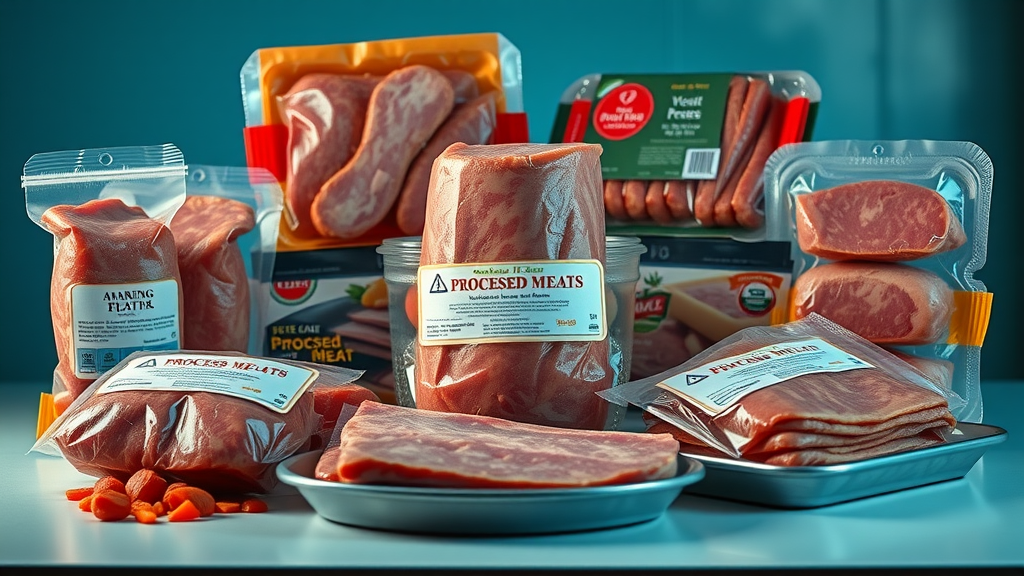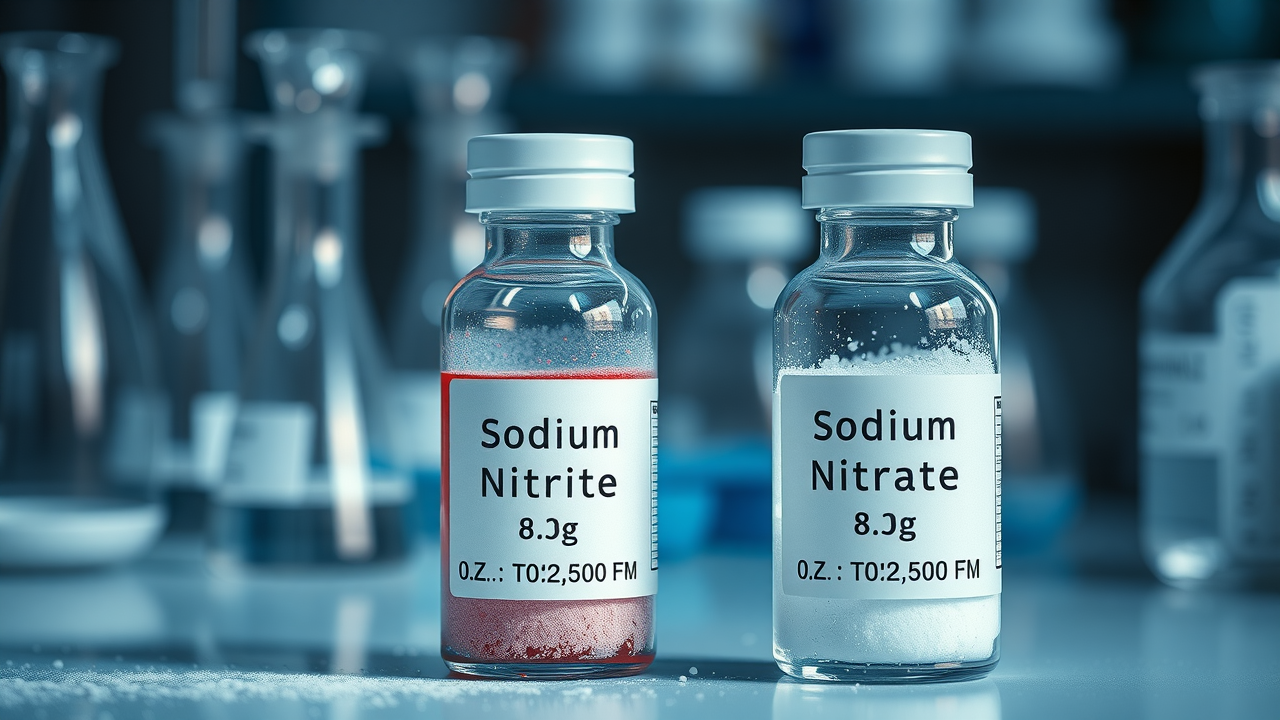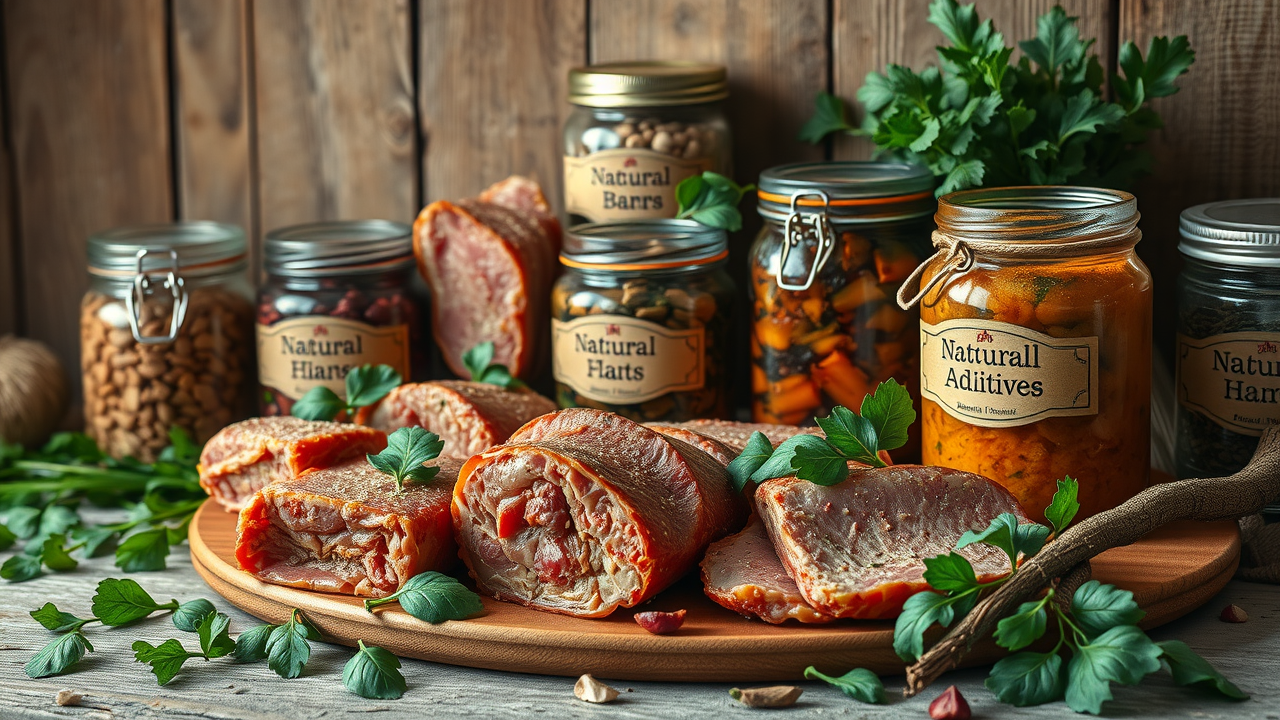Many of us trust processed foods without a second thought, but sodium nitrite lurking inside can threaten our health silently. Understanding its impact empowers you to protect your well-being and make safer dietary choices. Isn’t it time to uncover what’s really in your food?

Unmasking Sodium Nitrite: What You Need to Know
Opening Hook: Processed Food and the Reality of Sodium Nitrite
Every time you reach for that pack of bacon, ham, or hot dogs at the supermarket, you may not realize that the food additive sodium nitrite is helping preserve the appealing pink color and extended shelf life of these meat products. This additive is sodium nitrite—a widely used food additive that the meat industry relies on to prevent spoilage and ensure the safety of processed meat products. While sodium nitrite serves an essential role in food preservation, the reality behind its widespread use in meat products is far from simple.
Consumers often overlook the hidden ingredients in processed meats, yet growing scientific debate swirls around sodium nitrite. Organizations such as the World Health Organization warn that vast consumption of nitrite-rich foods may pose health risks that can't be ignored. As shoppers flock toward convenient, longer-lasting foods, sodium nitrite silently shapes what we eat and, potentially, how healthy we remain. Let’s peel back the packaging and scrutinize what this chemical is doing to your favorite foods and to your body.

The Role of Sodium Nitrite as a Food Additive in Meat Products
Why Sodium Nitrite is Used in Meat Product Preservation
Sodium nitrite is valued by the meat industry as a crucial food additive for more than just keeping meat products looking fresh. This food additive acts as a powerful preservative, inhibiting the growth of dangerous bacteria like Clostridium botulinum, the culprit behind botulism. By reacting with meat's natural components, sodium nitrite helps maintain that signature pink or red color in cured meat products, like hot dogs and deli ham.
The secret lies in its chemical reaction that releases nitric oxide, which interacts with proteins in meat products, resulting in both vibrant color retention and effective prevention of bacterial spoilage. Without sodium nitrite, many popular processed meats would quickly spoil or develop a dull and unappetizing appearance. This combination of food safety and pleasing presentation is why sodium nitrite is such a staple in meat product manufacturing worldwide.
For those interested in a deeper dive into the broader health implications of processed meats, including how sodium nitrite fits into the bigger picture, you may want to explore the hidden risks of processed meats and what you need to know. This resource unpacks additional factors that contribute to the health debate surrounding these foods.
Food Additives: Sodium Nitrite vs. Sodium Nitrate
Confusion between the food additives sodium nitrite and sodium nitrate is common among consumers and even within the meat product industry. Both compounds are forms of nitrite salt used as food additives in meat products, but they function a little differently. Sodium nitrate, when added to foods, gradually converts to sodium nitrite through chemical and bacterial reactions. It acts as a longer-lasting preservative for products designed to be stored over extended periods—like canned meats or some processed meats.
Sodium nitrite, on the other hand, is fast-acting and immediately effective for shorter shelf-life products such as deli meats and certain types of sausages. Both help preserve the red or pink color in meat, but sodium nitrite is typically responsible for the more vivid hue and quicker protection against bacterial threats. However, their difference is crucial, as the health effects and regulations for each are not identical, which we'll explore further.

Chemical Reaction: How Nitric Oxide Safeguards Meat Products
The real power of sodium nitrite as a food additive is unlocked through a fascinating chemical reaction that produces nitric oxide. Once introduced into meat products, sodium nitrite undergoes a chemical reaction forming nitric oxide, a compound that binds with myoglobin in muscle tissue. This bond yields the characteristic pink color in cured meats like ham, bacon, and hot dogs. Visually, this is vital for consumer appeal.
But there’s more: nitric oxide dramatically slows the process of spoilage by blocking the activity of harmful bacteria and pathogens. This dual function—preserving shelf life while maintaining food safety—is what keeps sodium nitrite indispensable in food production. Without this nitrite reacts process, the risks of foodborne illnesses and consumer dissatisfaction would surge for the meat industry.
Health Concerns: Sodium Nitrite and Its Impact
Possible Benefits of Sodium Nitrite in Controlled Amounts
It’s important to acknowledge that sodium nitrite isn’t purely a villain. When used within authorized limits, it’s a critical tool for food safety and even some medical uses. In moderate doses, sodium nitrite prevents the growth of deadly bacteria like Clostridium botulinum. For this reason, food safety organizations consider low levels of sodium nitrite to be acceptable in select meat products.
Beyond food, sodium nitrite is used in hospitals as an antidote for cyanide poisoning and in therapies involving sodium thiosulfate. The controlled conversion to nitric oxide in the body as well can help dilate blood vessels and play a role in certain medical settings. Nonetheless, there is a delicate balance, and even these potential benefits must be weighed against the mounting risks associated with chronic high intake.
Sodium Nitrite Risks: Cancer and Other Long-Term Consequences
Unfortunately, the same nitrite reacts process that helps preserve and color meats can also result in the formation of nitroso compounds. As numerous studies have shown, some of these compounds are considered carcinogenic to humans. In fact, the World Health Organization and International Agency for Research on Cancer have categorized processed meats containing sodium nitrite as probable causes of cancer, especially colorectal cancer.
Long-term consumption of processed meat high in sodium nitrite has been linked to elevated risks of stomach cancer, heart disease, and even metabolic issues. While regulatory agencies in the United States and Europe have put strict limits on allowable concentrations, ongoing research keeps the controversy alive. For many health-conscious consumers, these findings are cause for concern and a reason to rethink their weekly dietary choices.

Distinguishing Sodium Nitrite from Common Salt
Many consumers mistakenly view sodium nitrite as similar to everyday table salt, but their chemistry and impacts are vastly different. Common salt (sodium chloride) is essential for regulating hydration and nerve function, but sodium nitrite is entirely synthetic and serves a specialized role as a preservative and colorant in meat products.
Unlike salt, sodium nitrite is not used for taste, but for its ability to suppress bacterial growth and manipulate the visual presentation of foods. Excessive intake of sodium nitrite can be dangerous, while table salt, though not without its own risks in high quantities, is not directly associated with cancer pathways like nitrite salt. Awareness of these differences can help guide more informed choices at the grocery store.
Comparing Sodium Nitrite, Sodium Nitrate, and Table Salt — Uses, Functions, and Health Risks
Substance |
Primary Use |
Functional Effect |
Health Risks |
|---|---|---|---|
Sodium Nitrite |
Preservative in processed meat products |
Prevents bacterial growth, maintains pink/red color |
Potential cancer risk, long-term toxicity if consumed in excess |
Sodium Nitrate |
Preservative in cured meats, especially with long shelf life |
Converts to sodium nitrite over time; acts as slow-release preservative |
May pose similar risks as nitrite after conversion |
Table Salt |
Flavor enhancer, preservative |
Maintains fluid balance, flavor |
High intake linked to hypertension; not carcinogenic like nitrite |
Regulations and Safety: Is Sodium Nitrite Safe as a Food Additive?
Overview of Food Additive Policies in Different Countries
Regulations on sodium nitrite as a food additive vary widely around the world, reflecting the evolving science and public concerns. In the United States, the Food and Drug Administration (FDA) sets strict maximum limits for sodium nitrite in specific meat products, requiring clear labeling and oversight. The European Union also enforces similar restrictions, though some countries have gone further by mandating reduced levels or advocating alternatives to nitrites.
Agencies like the World Health Organization and the International Agency for Research on Cancer continue to publish findings and monitor potential risks, advising caution and ongoing review of authorized levels. The rationale behind these differing approaches lies in balancing the proven safety benefits against mounting biomedical research on cancer links. The global discourse highlights both consumer anxiety and scientific uncertainty.

Is Sodium Nitrite Banned in Europe? Addressing International Differences
Contrary to popular belief, sodium nitrite is not outright banned across Europe. Instead, its use is tightly regulated, with clear maximum permissible levels varying by food type and national policy. Countries such as Denmark and Norway have advocated for more restrictive measures, recognizing the latest research linking frequent nitrite consumption to cancer and other health risks. By contrast, southern European nations may allow slightly higher levels, provided strict monitoring is maintained.
Ongoing studies frequently prompt regulatory agencies to reassess current policies. As science advances, Europe has moved towards greater transparency in food additives regulation, driven in part by consumer advocacy and mounting health data. International differences reveal a complex landscape, where protecting public health must be balanced against practical food preservation needs.
Why Is Sodium Nitrite Allowed in Food Despite Health Risks?
Despite the risks, sodium nitrite remains legal primarily because it’s the most effective defense against foodborne illnesses like botulism in meat product production. Regulatory authorities have determined that, when levels are kept well below toxic thresholds, the public health benefits of bacterial prevention outweigh the potential cancer risks for most populations.
Furthermore, exposure to sodium nitrite from processed meat can be minimized through careful portion control and the inclusion of ascorbic acid (vitamin C) or erythorbic acid in recipes, which inhibit the formation of harmful nitrosamines. As food science evolves and safer alternatives are developed, agencies around the world continue to assess and update their standards to reflect new data.
Expert Perspectives: Dissecting Sodium Nitrite’s Controversial Status
"Consumers deserve full transparency and clear labeling when it comes to sodium nitrite in processed foods."
"Studies linking sodium nitrite to cancer cannot be ignored, yet regulatory authorities still wrestle with acceptable levels."
Sodium Nitrite in Processed Foods: Recognizing Where It Appears
Sodium nitrite in deli meats: Common in ham, turkey, roast beef, and sliced cold cuts for its role in preservation and color retention.
Sodium nitrite in bacon and sausages: Maintains shelf life and signature flavors in breakfast and dinner staples.
Sodium nitrite in canned meats: Helps ensure longevity and food safety in packaged products.
Other processed foods containing sodium nitrite: Can include certain cheeses, fish, and preserved snacks. Always check labels.

Chemical Reaction: How Sodium Nitrite Preserves and Colors Food
Understanding the Science Behind Sodium Nitrite’s Effects
Sodium nitrite’s unique capabilities as a food additive stem from intricate chemical reactions that preserve and color meat products. When added to meat products, sodium nitrite dissolves into an aqueous solution and interacts with natural muscle proteins. This reaction produces nitric oxide, which binds to myoglobin, stabilizing the vibrant red color that’s synonymous with cured meats.
This chemical reaction is what gives ham, bacon, and hot dogs their characteristic hue—and also prevents spoilage by inhibiting bacterial growth. The process is so reliable that few non-nitrite solutions can replicate both the safety and the color retention essential for processed meat appeal. It’s a double-edged sword: safeguarding public health while introducing a potential long-term risk.

Alternatives to Sodium Nitrite in Meat Products and Food Additives
Natural preservatives for meat products: Celery powder, sea salt, rosemary extract, and vinegar can substitute, though efficacy and flavor stability vary.
Non-nitrite food additives: Ascorbic acid (vitamin C), erythorbic acid, and other antioxidants help reduce bacterial growth without nitrosamine formation.
Emerging food safety technologies: High pressure processing, cold plasma, and advanced packaging reduce spoilage without chemical preservatives.

Personal Opinion: Should Sodium Nitrite Be Banned in Meat Products?
Balancing Food Safety and Health Risks
Banning sodium nitrite outright is a contentious issue. While its dangers are increasingly recognized, there is no denying its historical success in preventing foodborne illnesses in meat product processing. The future of food additives needs a more nuanced approach—reducing nitrite content wherever possible, investing in thorough research, and combining natural preservation strategies with modern technology.
Ultimately, consumers deserve clear information so they can make informed choices about the foods they buy. Direct bans could compromise food safety if substitutes aren’t equally effective. What’s vital is continuing to lower permitted levels and rapidly transitioning toward safer, natural preservation methods whenever possible.
Moving Forward With Caution: What Consumers Can Do
As debate swirls, the role of the consumer shouldn’t be underestimated. Start by reading labels closely—look for “nitrite-free” or “no added nitrates/nitrites” on processed meat packaging. Limit intake of cured meats and opt for fresh alternatives when feasible. Ask questions at delis and grocery stores, and advocate for transparency in ingredient disclosure. Supporting brands that invest in natural preservation and environmentally-friendly techniques drives progress in the industry.

Practical Tips: Reducing Sodium Nitrite Intake
Read labels for sodium nitrite and food additives: Familiarize yourself with ingredient names and avoid products with high-nitrite content.
Choose fresh over processed meat products: Fresh meats are less likely to contain sodium nitrite or other chemical preservatives.
Opt for products labeled as nitrite/nitrate free: Many producers now offer alternative options; choose “uncured” or “naturally preserved” when possible.
Prepare meals at home using whole ingredients: Control what goes into your meals and avoid unnecessary additives by cooking from scratch.

People Also Ask About Sodium Nitrite
Is sodium nitrite harmful?
While sodium nitrite is effective at preventing bacterial growth in meat products, research links high levels of sodium nitrite intake to health risks such as certain cancers and potential long-term toxicity. Regulatory limits aim to mitigate these risks but ongoing studies fuel continued debate.
Is sodium nitrite banned in Europe?
Sodium nitrite is not universally banned in Europe; however, some countries regulate its usage strictly in food products, with maximum allowable limits and ongoing assessments based on new research.
Is sodium nitrite just salt?
Sodium nitrite is not the same as common salt (sodium chloride); chemically and functionally, they are distinct. Sodium nitrite is used primarily as a preservative and colorant and can be harmful in higher quantities.
Why is sodium nitrite allowed in food?
Sodium nitrite is permitted in food primarily for its effectiveness in preventing botulism and preserving the appearance of processed meats. Regulatory bodies set limits to ensure safety, though controversy over its use persists.
FAQs About Sodium Nitrite in Food Additives
Does cooking meat products lower sodium nitrite risks?
Cooking can reduce the presence of sodium nitrite to a certain degree, but it may also trigger reactions that form potentially harmful nitrosamines, especially at high temperatures. Always use gentle, moist-cooking methods for processed meats and pair them with vitamin C-rich foods to lower risks.How can consumers spot sodium nitrite in food labels?
Look for ingredients such as “sodium nitrite,” “potassium nitrite,” or E250 on labels. Some manufacturers may use celery powder or juice as a ‘natural’ nitrite source, so investigate further if you want to avoid all forms.What other food additives may pose similar concerns?
Other preservatives such as sodium nitrate, BHA, and BHT are also scrutinized for long-term health effects. Always research food additives and opt for brands with transparent sourcing and labeling practices.
Conclusion: Rethinking Sodium Nitrite in Your Diet
Making Informed Choices About Food Additives and Processed Meat Products
Knowledge empowers choice—by understanding the facts about sodium nitrite, you can protect your health, support safer food industry practices, and inspire change for future generations.
If you’re ready to take your understanding of food and health to the next level, consider how dietary patterns as a whole can influence your long-term well-being. Beyond sodium nitrite, the types of carbohydrates and other ingredients you consume may also play a significant role in chronic disease risk. For a broader perspective on how everyday foods impact your health, explore the big lie about carbohydrates and chronic disease. This deeper dive can help you make even more empowered choices for a healthier future.
Protect Your Health — Read Food Labels and Demand Transparency on Food Additives Like Sodium Nitrite
Your grocery cart shapes both your well-being and industry standards. Let’s demand clear labeling, support natural alternatives, and share what we learn about food additives like sodium nitrite with friends and family.
Sources
https://www.fda.gov/food/food-additives-petitions/overview-food-ingredients-additives-colors
https://www.cancer.org/latest-news/what-are-processed-meats-and-why-are-they-linked-to-cancer.html
Sodium nitrite is a common food additive and preservative in processed meat products, valued for its ability to inhibit bacterial growth and maintain the appealing pink color of items like bacon and hot dogs. However, its safety has been a topic of concern. When sodium nitrite interacts with certain compounds in the stomach, it can form nitrosamines, substances known to be carcinogenic. The World Health Organization has classified processed meats as carcinogenic to humans, partly due to these compounds. (en.wikipedia.org)
Regulatory bodies have established limits on sodium nitrite usage to mitigate health risks. In the United States, the Food and Drug Administration permits its use under specific conditions, such as a maximum of 200 parts per million in certain cured meats. (law.cornell.edu) Despite these regulations, some health experts advocate for stricter controls, citing studies that link high consumption of nitrite-rich foods to increased cancer risk. (ewg.org)
For consumers concerned about sodium nitrite intake, it’s advisable to read food labels carefully and opt for fresh, unprocessed meats when possible. Being informed about food additives and their potential health impacts empowers individuals to make safer dietary choices.
 Add Row
Add Row  Add
Add 




Write A Comment